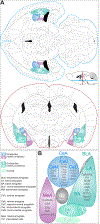Valence coding in amygdala circuits
- PMID: 32832584
- PMCID: PMC7440104
- DOI: 10.1016/j.cobeha.2018.10.010
Valence coding in amygdala circuits
Abstract
The neural mechanisms underlying emotional valence are at the interface between perception and action, integrating inputs from the external environment with past experiences to guide the behavior of an organism. Depending on the positive or negative valence assigned to an environmental stimulus, the organism will approach or avoid the source of the stimulus. Multiple convergent studies have demonstrated that the amygdala complex is a critical node of the circuits assigning valence. Here we examine the current progress in identifying valence coding properties of neural populations in different nuclei of the amygdala, based on their activity, connectivity, and gene expression profile.
Conflict of interest statement
Conflict of interest statement Nothing declared.
Figures



References
-
- Lewin K: The Conceptual Representation and the Measurement of Psychological Forces. Duke University Press; 1938.
-
- Russell JA: A circumplex model of affect. J Pers Soc Psychol 1980, 39:1161–1178.
-
- Tinbergen N: The Study of Instinct. Clarendon Press; 1951.
Grants and funding
LinkOut - more resources
Full Text Sources
Miscellaneous
